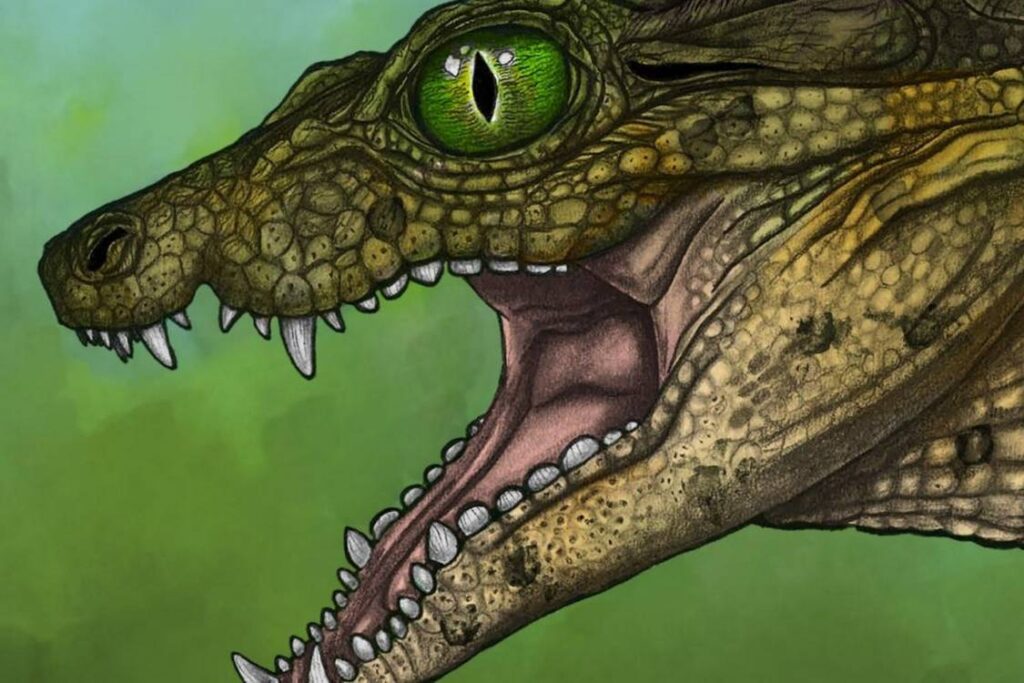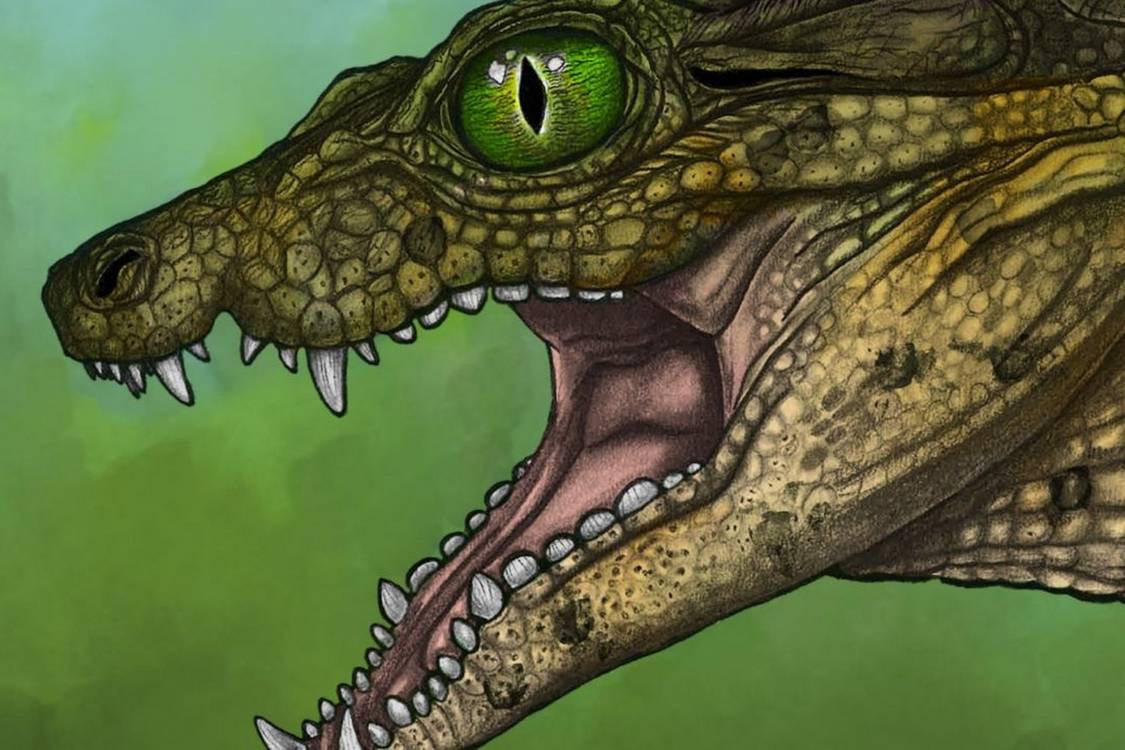 Illustration by Dane Johnson, Museum of the Rockies – released to the press
Illustration by Dane Johnson, Museum of the Rockies – released to the press
Measuring no more than 2 feet long from nose to tail, a newly-described crocodilian nicknamed “Elton” likely lived its entire life on land where it lounged in the Cretaceous Montana sunshine, eating plants and insects.
Elton was about the size of a big lizard, according to Montana State University professor of paleontology David Varricchio, whose former Ph.D. student Harrison Allen managed to spot the 1.9-inch-long skull of the animal on an excavation trip in 2021.
Had it lived to be fully grown, Elton would have measured no longer than 3 feet, far smaller than most members of the crocodilian family known today or to have ever lived. Adapted to live on land, it probably ate both plants and insects or small animals with its assortment of differently shaped and specialized teeth.
Its unique anatomy singles it out as belonging to a new, previously unrecognized family of crocodyliforms endemic to the Cretaceous of North America.
During a dig in the summer of 2021 in the Blackleaf geological formation on US Forest Service land near Dillon, Montana, Allen noticed a fossil the size of the tip of his pinkie with a “weird texture on it.”
“I brought it to Dr. Varricchio and knew it must be something good, because he said, ‘Take me to where you found this,’” said Allen, who is now studying croc paleontology as a doctoral student at Stony Brook University in New York.
Four years and hundreds of hours of study later, he is the lead author of a paper published in the Journal of Vertebrate Paleontology that describes the morphology and scientific significance of the creature whose remains he found in the Blackleaf Formation.
“We have found dinosaurs (in the Blackleaf) before, but this was the second known vertebrate animal we’d ever found in this formation,” he told his university press.
The extinct animal, which Allen and his co-authors later named Thikarisuchus xenodentes for its strange, sheathed teeth, has provided new information about the patterns of evolution in the croc family tree.
It also provided the ultimate undergraduate research project for Allen, who delved into the painstaking process of excavating, sifting and reconstructing the Thikarisuchus remains with the help of some fellow students.
“As an undergraduate student new to research, I nervously went up to Dr. Varricchio and asked if I could study this specimen,” Allen said. “It led me down the rabbit hole into this amazing world of prehistoric, extinct crocs and their evolutionary niches.”
The day after Allen recovered the first piece of skeleton, he and his classmates scooped up several bags of sediment from the mound where it was found. Back in Bozeman, Allen and his friend Dane Johnson spent between nearly 20 hours sifting out fine particulate matter and dirt, eventually recovering dozens of tiny pieces of the Thikarisuchus skeleton that collectively fit into the palm of Allen’s hand.
As they worked, they listened to music, including Elton John’s 1970s hit “Crocodile Rock.” The nickname “Elton” stuck, long before the specimen was assigned the scientific name that reflects its physical traits.
Allen and Johnson recovered bits of bone from almost all areas of the animal’s body, including its limbs, vertebrae, jaw, and skull. Because the fragments were tiny and exceptionally fragile, the students didn’t attempt to physically reassemble them. Instead, they took them for a series of CT scans before coloring the digital, 2D segment slices that the scans produced, a process necessary to visually distinguish the bones from the rocks they were embedded in.
PREHISTORIC REPTILES: New Triassic Reptile Has Enormous Crest Unknown to Science That Upends Feather Evolution Theories
“Harrison worked super hard to digitally reconstruct the animal, and it came out beautifully,” said Varricchio of his former student.
During the process, Allen discovered that the bones of Thikarisuchus were densely concentrated and organized in a manner consistent with fossils of organisms found in burrows in the Blackleaf Formation and the nearby Wayan Formation in Idaho. He said this suggests that Thikarisuchus was likewise preserved within a burrow.
The specimen also presented clues about Thikarisuchus’ newly named family group Wannchampsidae and a similar group found in Eurasia known as Atopasauridae. Both groups were tiny and terrestrially adapted, and they shared certain cranial and dental features found in another more distantly related group from the Cretaceous of Africa and South America.
OTHER CROCS FROM OTHER CONTINENTS: Exquisite New Fossil Shows Scientists How Much More Ferocious Australia’s Crocs Once Were
“It suggests that during the same time period, we’re seeing convergent evolution between two distantly related groups due to similar environmental conditions, prey availability and who-knows-what that prompted crocs on opposite sides of the planet to develop similar features,” Allen said.
“The majority of diversity of crocodyliforms is in the past. There were fully marine crocs, fully terrestrial crocs, herbivorous crocs, omnivores, and some that cracked shells,” he said. “That amazed me and made me want to get into this more specific realm of paleontology.”
SHARE This Prehistoric Croc And Its Unlikely Lifestyle With Your Friends…

